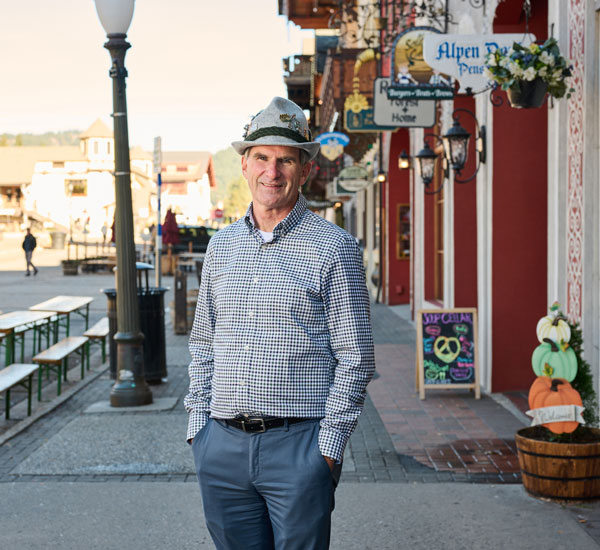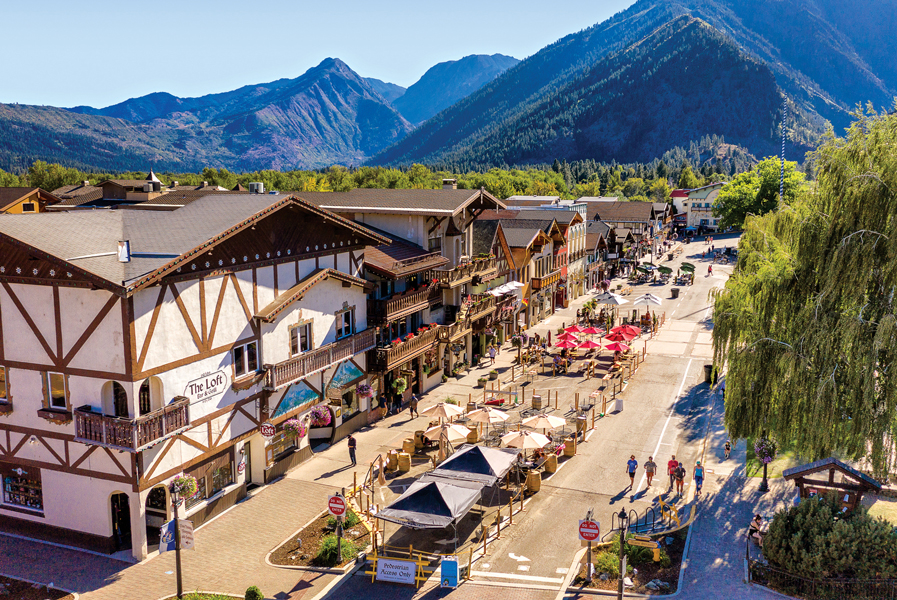by
<a href="mailto:communicationsteam@awcnet.org">Communications</a> | Dec 11, 2023
The City of Leavenworth uses measures adopted during the pandemic to plan a more resilient tourism future.
The City of Leavenworth uses measures adopted during the pandemic to plan a more resilient tourism future.
By: Allyson Meyer
Steeped in Bavarian charm and picturesque against its mountainous backdrop, the City of Leavenworth has long been an enticing destination for visitors. Then the COVID-19 pandemic threatened the town’s vibrant tourism industry, with statewide stay-at-home orders going into effect on March 23, 2020. Many questioned how a community reliant on visitors could survive. By May, however, it became clear that even a global health crisis wasn’t keeping travelers away.
“We were basically completely shut down for just a couple of months, and then people were showing up; they were coming anyway,” says Mayor Carl Florea. “I think partially because people weren’t traveling by plane, but they wanted to get away and it’s a beautiful place to visit. We actually saw tourism numbers going up during COVID.”

Mayor Carl Florea on Leavenworth’s Front Street. Credit: Chona Kasinger
Next came the difficult task of making sure a destination known for its hospitality was ensuring the safety of inhabitants and tourists. With an emergency declaration in May 2020, Florea closed Front Street—downtown Leavenworth’s primary thoroughfare—to vehicular traffic, creating a pedestrian zone where social distancing guidelines could be followed, with handwashing stations and masks distributed free of charge.
Florea says he faced backlash early on from business owners who worried decreased parking access would discourage customers from shopping and eating out. In response, city staffers and volunteers converted Front Street into an outdoor dining hall and pedestrian mall, placing street furniture and tables and chairs throughout the zone.
A change instigated by the pandemic crisis became something more—an opportunity for the community to improve the experience of visitors, become more adaptable, and grow the city’s resilience. In fact, the change proved so successful that in July, the mayor extended the closure through the end of summer, and it ultimately became permanent.

To promote social distancing during the pandemic, Leavenworth converted Front Street into an outdoor dining hall and pedestrian mall; the temporary street closure proved to be so popular it ultimately became permanent. Credit: Courtesy Icicle TV
As pandemic-era measures have become part of Leavenworth’s community fabric, the city plans to replace makeshift barricades on Front Street with pneumatic barriers and is looking at ways to redesign its downtown streetscape to make it more pedestrian-friendly and address parking concerns.
Another lesson learned from the pandemic, Florea says, was turning the city’s traditional Christmas lighting from a one-day “flipping of the switch magical moment” into a seasonal celebration, with lights on from Thanksgiving to February.
“Tourism isn’t just about the numbers, it’s about effective numbers and what you can deal with realistically,” he says. “Trying to sustain tourism means getting those numbers to spread out more evenly so you have crowds of 5,000 coming consistently over many days rather than crowds of 10,000 on a single day.”
Tourism isn’t just about the numbers, it’s about effective numbers and what you can deal with realistically,
Ultimately, he says, it comes down to keeping a small-town feel while creating a welcoming environment for visitors.
“I hear from tourists that they love feeling like they are coming to a village,” says Florea. “My hope is that we sustain that village as well as the tourism.”
And cultivate a more resilient tourism future for the community.